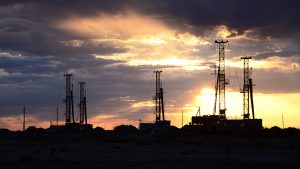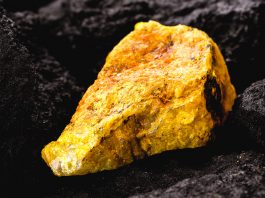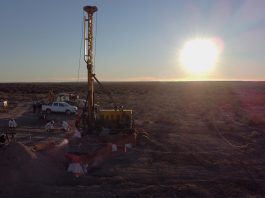Blue Sky Uranium targets expanding its district-scale, low-cost uranium project in Rio Negro province, Argentina, with an inferred resource of 22.7 million pounds U3O8.
Now that Russian exports of uranium and nuclear fuel are no longer acceptable in Western markets, new sources of low-cost uranium are needed. Here, we address the potential for abundant economic uranium in Argentina, where Blue Sky Uranium’s Amarillo Grande project is the most advanced and holds the largest resource.
The global uranium market is in disarray
When Putin launched the attack on Ukraine in February last year, the uranium market was put on notice. He followed that up by weaponising Russian gas and oil by selectively withholding supply from most European markets – regardless of contractual agreements – to penalise Western allies of Ukraine.
Putin has made it clear that Western countries can no longer rely on Russian uranium and enriched low-cost uranium to generate electricity.
Concurrently, since uranium is a strategic mineral, like oil and gas, Western countries will no longer accept these imports from Russia, which are crucial for funding Putin’s war efforts. Bipartisan legislation is pending in both houses of the US Congress, HR 1042 in the House and ROS23164 in the Senate as of March this year.
This development has left Western countries – and the entire green energy and decarbonisation drive – in disarray and scrambling for new sources of uranium to power the increasing number of nuclear reactors globally (437 at last count, with 59 in construction according to the World Nuclear Association in March 2023).
Thus far, contracts signed prior to the Ukraine war by US utilities – the world’s largest user of uranium – and Rosatom – the Russian state atomic energy monopoly founded by Putin – are still being honoured by both sides.
Regarding a cleaner, greener future
Russia, Kazakhstan, and Uzbekistan produced 58% of the world’s uranium in 2021. Russia holds 46% of the world’s capacity to enhance uranium into nuclear fuel. In addition, China is aggressively expanding its enhancement capacity.1
Regarding the vital green revolution, nuclear energy provides 10% of global electricity and 26% of green electricity, according to the Energy Information Administration, providing more than 50% of green electricity in the US alone.
One uranium fuel pellet – weighing less than ten grams – replaces one ton of coal or 149 gallons of oil or 17,000 cubic feet of natural gas, as stated by the Nuclear Energy Institute. News agencies, based on high-level government statements, report that nuclear energy plays a vital role in decarbonising the future and is backed by both the US and European Union.

Western-world utilities and governments that operate nuclear plants for electricity urgently need to increase uranium production. The issue is that it takes many years to get a qualified, low-cost uranium project into production.
To alleviate this issue, there is a need for emerging developers of low-cost uranium with the potential to ramp up to world-class quantities of production.
One of the few prospects is in nuclear-savvy Argentina, in the uranium-savvy Rio Negro province, at the district-scale Amarillo Grande project controlled 100% by Blue Sky Uranium Corp. (BSK.V; BKUCF.OTC). This project is big – a trend that is 145km long by 50km wide, equivalent to 1.5 times the size of Delaware.
At the far south end of the trend, BSK has an initial resource estimate and preliminary economic assessment (PEA) on the Ivana deposit. This study was performed by independent engineers Kuchling et. al. Ivana has a starting inferred resource of 22.7 million pounds of uranium with 11.5 million pounds of vanadium (28.0 million tonnes averaging 0.037% U308 & 0.019% V2O5 at a 100ppm uranium cut-off) the largest in Argentina and one of the largest in South America.
PEA demonstrates low-cost uranium potential
The preliminary economic assessment (PEA) demonstrates that low-cost uranium is possible – it will be well within the lowest 25% of production costs globally. All-in sustaining costs (AISC) are estimated to be below $20/lb.
Amarillo Grande is flat-lying, semi-arid and accessible year-round with nearby rail, power, and port access.
The Ivana deposit lies at surface and the gravels and sand and, lower down, the sandstone are amenable to shovelling, hauling, wet scrubbing, and screening to remove impurities, leaching out the uranium and vanadium using sodium bicarbonate, and drying into uranium oxide (U3O8) – the standardised commercial product marketable globally.
Targeting low-cost uranium resource expansion
Since 2018, BSK’s geological field crews have performed geochemical and geophysical surveys through much of the Amarillo Grande project area. At least four new uraniferous zones need to be drilled.
In 2021 and 2022, the company drilled over 5,000m, including in-fill and expansion drilling at Ivana, plus the first holes at Ivana Central and Ivana North, which are both large prospects at approximately 4km x 7km each. Ivana Central lies 10km north of Ivana and Ivana North lies 20km north of Ivana.
As stated in company news from 28 September 2021 and 2 February 2022, it is clear that an expansion of resources to the west of the Ivana deposit is anticipated. A good portion of the inferred resource is expected to get upgraded to indicated resources.
It is too early to state potentials at Ivana Central or Ivana North – or the next two uraniferous zones to be drilled, Ivana East and Cateo Cuarto.
Drilling is in progress
After extensive geophysical and geochemical workups at Ivana East – 10km east of Ivana – 1,200m of reverse circulation drilling has commenced on initial drill targets.
At Cateo Cuarto, 32km southwest of Ivana, fieldwork is in progress to establish the first drill targets.
When the uranium is at or near the surface, with holes just 10-40m deep, what might appear to be a small drilling campaign can go a long way.
If merited, the second resource estimate is targeted to be announced this year. Ongoing drilling will accompany the engineering studies to report the results of the prefeasibility study targeted to be reported next year.
With the floor starting at 22.7 M lbs, grading a highly favourable 311 parts per million, the opportunity here has a big sky.

Argentina is nuclear savvy
It might surprise you that Argentina is a leading hub of nuclear understanding and progress in South America.
It has an advanced nuclear industry, which encompasses:
- Three operational nuclear power plants;
- Six research reactors;
- Four particle accelerators;
- A uranium purification plant;
- One nuclear power plant under construction; and
- Two additional plants in planning and two under proposal.
Yet, there is no low-cost uranium production in Argentina, as all uranium is imported from Asia. Argentina has its own enrichment facilities and enriches the imported uranium into nuclear fuel for its operating plants.
The legal framework there guarantees the purchase of low-cost uranium by the utilities from any producer in Argentina.
Rio Negro Province is itself a strong nuclear jurisdiction
Rio Negro Province, where Blue Sky’s Amarillo Grande project is located, has broad local nuclear experience. A research nuclear reactor, hydro-metallurgical lab, and the country’s pilot uranium enrichment plant are in the Rio Negro province.
If uranium production commences at Amarillo Grande, it can be enriched directly into nuclear fuel in the same province for sale and use by Argentina’s nuclear plants and for export. By comparison, the US has no operational enrichment facilities.
Management gives Blue Sky advantages
Blue Sky has a strategic advantage in Argentina. The company is a member of the Grosso Group – a management team that pioneered the mineral exploration industry in Argentina in 1993 – and has been involved with four exceptional mineral deposit discoveries already, all in Argentina.
Blue Sky management is proud to have strong relationships that have been built over the decades with local, provincial, and federal officials, as well as strong community and cultural ties.
Green energy specialists and speculative investors will find a lot to like about Blue Sky Uranium. With today’s market value of just $20m, the floor of the basement has been well established. To learn more, including key maps and studies, visit www.blueskyuranium.com and register for breaking news.
References
- WNA, World Nuclear Performance Report 2021
Please note, this article will also appear in the fourteenth edition of our quarterly publication.









